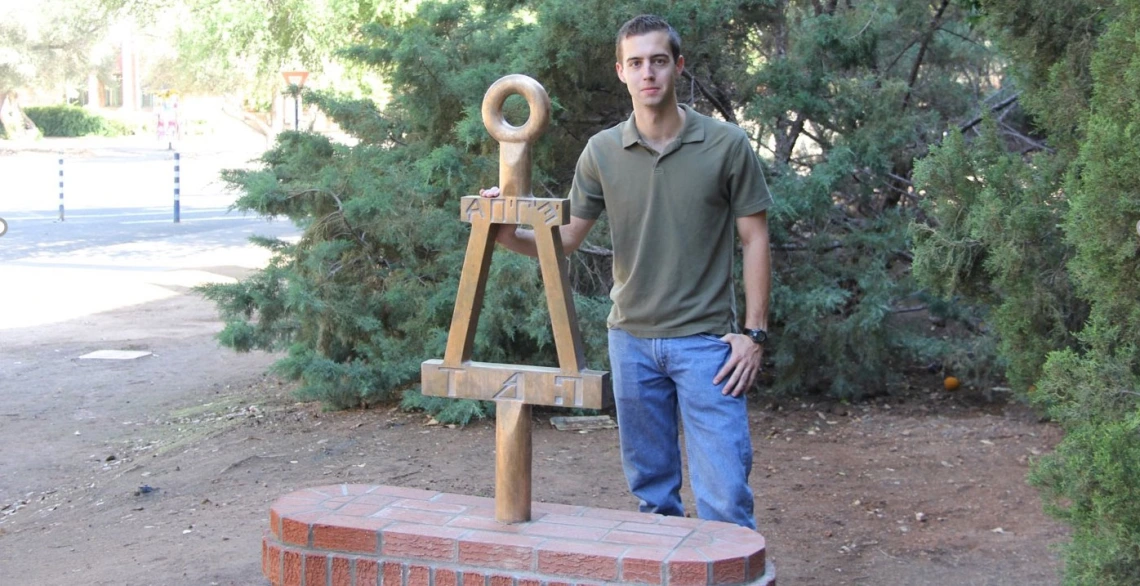Engineering Sculpture Tells Many Stories
Unusual bent sculpture outside Old Engineering has an interesting history, uncovered by a student as he campaigned to get the honor society sculpture installed.

Adam Rice and the bronze bent outside the Old Engineering building on the UA campus.
Are you wondering about that odd-looking bronze sculpture outside Old Engineering?
It's called a bent.
The bent is the official symbol of Tau Beta Pi, the oldest engineering honor society in the U.S. The society was formed in 1885, the same year UA was established, and honors engineering students with high academic achievement and exemplary character.
Adam Rice, a 2011 chemical engineering graduate and last year's president of the Arizona Alpha chapter of Tau Beta Pi, recently rescued this particular bent from obscurity.
The bent sculpture outside Old Engineering has an interesting history, which Rice uncovered as he campaigned to get the sculpture installed. "The sculpture was donated to the UA chapter of Tau Beta Pi in 2003 by John Pattison, who had it cast in memory of his father, Karl Pattison, who died in 2002," Rice said. "Both Pattisons are Arizona Alpha chapter members," Rice added.
Rice heard about sculpture from a previous Tau Beta Pi president. Somehow, it had ended up in the yard of Karl Pattison's house instead of proudly displayed on campus. "I made it my mission to restore it to its rightful place," Rice said.
The society's official badge is actually a watch key in the shape of a trestle frame, or bent, with a lower shaft for winding pocket watches, and an upper shaft with a ring so the key could be worn as a pendant.
The lower letters are the Greek characters for Tau Beta Pi. The upper letters, however, are secret and only become known upon induction into the society. On the back of the bronze cast now on campus, the inscription reads "In Memory of Karl Modjeska Pattison, 1921-2002."
Karl Pattison grew up not far from the UA campus in an old homestead established in the late 1800s. He flew B-29s in World War II and graduated from UA in 1950 with a mechanical engineering degree. After working at Hughes Aircraft Company for 25 years, he became a UA visiting professor and taught mechanical engineering design. "He loved to teach and work with students," said John Pattison, a UA engineering physics graduate and adjunct researcher in the physics department.
The rambling old house still stands, a few blocks north of the UA campus, and is a testament to decades of engineering design and research. Some rooms are packed floor to ceiling with engineering projects that span Karl Pattison's fuel-efficiency research from 50 years ago to John Pattison's current solar energy experiments. "Engineering students were always around the house," recalls the younger Pattison. "I guess all that engineering design rubbed off on me without me knowing it."
The cast of many who helped bring the bent to its current location includes UA alums and local engineering companies. The junior Pattison commissioned the cast from a foundry in Bisbee, Ariz. The inscription was done by UA mechanical engineering alum Jim Short, who founded Tucson engineering company Tahl Inc. in 1987, and TA Caid Designs did the polishing of the rough cast. A crew from campus facilities built the brick plinth and set the sculpture in place.
Rice completed his mission to install the bent around the time he graduated in May 2011. He is now working for Hunt Energy in Dallas as a special projects engineer developing oil and gas fields around the world, a job that sits well with his desire to travel. "I'm interested in spending more time in South America," Rice said. "And I want to visit the Middle East to see what it's like and understand the culture."

